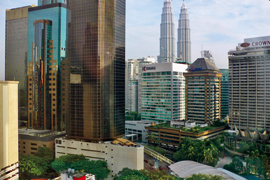The Mitsui & Co. Environment Fund
Introduction to Grant Projects
Hiroshima University, IDEC (Graduate School for International Development and Cooperation), Division of Development Science, Development Technologies Course Associate Professor Toru Kubota
Projections of heat island effect after implementation of city master plans in the major cities of emerging countries of Southeast Asia and mitigation proposals
Research grant
- Project Description
The project will make projections of heat island effects after the implementation of city master plans in the major cities of emerging countries of Southeast Asia through simulations using a meso weather model, and in doing so quantify the increased amount of energy consumption for air conditioning. The target cities are the five cities of Hanoi in Vietnam, Bangkok in Thailand, Kuala Lumpur and Johor Bahru in Malaysia, and Jakarta in Indonesia. First, we will conduct a simulation of the urban climate currently and after the implementation of master plans. Then we will compare the energy consumption for air conditioning before and after implementation of the master plans. Furthermore, we will jointly consider heat island mitigation measures based on the situation in each city with local researchers, and quantify the energy saving effect through those mitigation measures.
- Fields
- Climate changeEnergy problem
- Grant year
- FY2011 Research Grants
- Grant term
- 3 years
April 2012 - March 2015
- Grant amount
- 6,800,000 yen
- Activity region
- Johor Bahru, Kuala Lumpur, Bangkok, Hanoi, and Jakarta

Overview of the Organization

- Representative
- Toru Kubota, Associate Professor
- Profile
- Specialist field
Architecture and urban environmental engineering
Affiliated academic societies
Architectural Institute of Japan
Background
Graduated with a doctorate in engineering from the Shibaura Institute of Technology Graduate School in 2001, specializing in regional environmental systems. After serving as a visiting researcher at that university, served as postdoctoral researcher at Faculty of Built Environment, University of Malaya. Served as Japan Society for the Promotion of Science Fellow at that university from 2004-2006. Then served as Full-Time Lecturer at that university's Faculty of Built Environment from 2005-2009. Has served as Hiroshima University, IDEC (Graduate School for International Development and Cooperation), Associate Professor since 2009. - WEB site
- http://home.hiroshima-u.ac.jp/tetsu/index.html
- Collaborating researchers
- Hiroshima University/Associate Professor/Takahiro Tanaka, Hiroshima University/Assistant Professor/Han Soo Lee, University of Malaya/Instructor/Dilshan Remaz Ossen, Bandung Institute of Technology/Instructor/Surjamanto Wonorahardjo, Vietnam Institute of Architecture, Urban and Rural Planning/Researchers/Mai Dinh Ngoc and Tran ThiThu Phuong, Asian Institute of Technology/Associate Professor/Ranjith Pereram Kasetsart University /Instructor/Sigit D. Arifwidodo
- Research record
-
- (1) Toe, DHC., Kubota, T. (2013) Field measurement on thermal comfort in traditional Malay houses, AIJJ. of Technology and Design, 19(41) (in press)
- (2) Surahman, U., Kubota, T. (2012) Development of a simplified LCA model for residential buildings in Indonesia: a pilot survey in Bandung, AIJ J. of Technology and Design, 18(40), pp.1003-1008.
- (3) Kubota, T. and Toe, DHC. (2010) Potential of passive cooling techniques for modern houses in tropical climate of Malaysia: analysis of indoor thermal environment with various ventilation strategies, Int'l J. of Ventilation, 9(1), pp.11-23.
- (4) Kubota, T., Toe, DHC. and Ahmad, S. (2009) The effects of night ventilation technique on indoor thermal environment for residential buildings in hot-humid climate of Malaysia, Energy and Buildings, 41(8), pp.829-839.
- (5) Kubota, T., Miura, M., Tominaga, Y. and Mochida, A. (2008) Wind tunnel tests on the relationship between density and pedestrian-level wind velocity: development of guidelines for realizing acceptable wind environment in residential neighborhoods, Building and Environment, 43(10), pp.1699-1708.